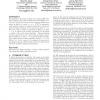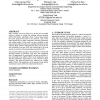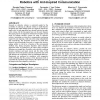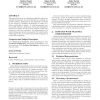GECCO
2005
Springer
14 years 7 months ago
2005
Springer
A meta-GA (GA within a GA) is used to investigate evolving the parameter settings of genetic operators for genetic and evolutionary algorithms (GEA) in the hope of creating a self...
GECCO
2005
Springer
14 years 7 months ago
2005
Springer
An analysis for the phase transition in a random NK landscape model is given. For the fixed ratio model, NK(n, k, z), Gao and Culberson [17] showed that a random instance generat...
GECCO
2005
Springer
14 years 7 months ago
2005
Springer
The three mechanisms of crossover are transmission, assortment, and respect. Of these three mechanisms, assortment (i.e. recombination) is traditionally viewed as the primary feat...
GECCO
2005
Springer
14 years 7 months ago
2005
Springer
A quality-time analysis of multi-objective evolutionary algorithms (MOEAs) based on schema theorem and building blocks hypothesis is developed. A bicriteria OneMax problem, a hypo...
GECCO
2005
Springer
14 years 7 months ago
2005
Springer
Computationally identifying transcription factor binding sites in the promoter regions of genes is an important problem in computational biology and has been under intensive resea...
GECCO
2005
Springer
14 years 7 months ago
2005
Springer
Edge Assembly Crossover (EAX) is by far the most successful crossover operator in solving the traveling salesman problem (TSP) with Genetic Algorithms (GAs). Various improvements ...
GECCO
2005
Springer
14 years 7 months ago
2005
Springer
Research in collective robotics is motivated mainly by the possibility of achieving an efficient solution to multi-objective navigation tasks when multiple robots are employed, in...
GECCO
2005
Springer
14 years 7 months ago
2005
Springer
This paper introduces an evolutionary algorithm which uses multiple chromosomes to evolve solutions to a symbolic regression problem. Inspiration for this algorithm is provided by...
GECCO
2005
Springer
14 years 7 months ago
2005
Springer
In this paper the potential of GP-generated symbolic regression for alleviating multicollinearity problems in multiple regression is presented with a case study in an industrial s...
GECCO
2005
Springer
14 years 7 months ago
2005
Springer
Cochlear implants are electronic devices that stimulate directly the auditory nerve to allow totally deaf patients to hear again. This paper presents an interactive evolutionary a...




